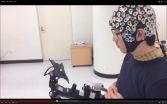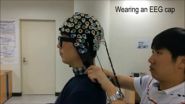INFORMATION:
Notes to Editors
A video of the device being tested is available:
Video (credit: © Korea University / TU Berlin)
The full paper, video, and an image can be downloaded here.
Contact
For further information, a full draft of the journal paper or contact with one of the researchers, contact IOP Senior Press Officer, Steve Pritchard: Tel: 0117 930 1032 E-mail: steve.pritchard@iop.org. For more information on how to use the embargoed material above, please refer to our embargo policy.
Enquires in German language should be made to Stephanie Terp, Press Officer, TU Berlin - steffi.terp@tu-berlin.de.
IOP Publishing Journalist Area
The IOP Publishing Journalist Area gives journalists access to embargoed press releases, advanced copies of papers, supplementary images and videos
Login details also give free access to IOPscience, IOP Publishing's journal platform. To apply for a free subscription to this service, please email the IOP Publishing Press team at ioppublishing.press@iop.org, with your name, organisation, address and a preferred username.
A lower limb exoskeleton control system based on steady state visual evoked potentials
The published version of the paper 'A lower limb exoskeleton control system based on steady state visual evoked potentials' (J. Neural Eng. 12 056009) will be freely available online from Tuesday 18 August 2015. It will be available at http://iopscience.iop.org/1741-2560/12/5/056009.
Journal of Neural Engineering
Journal of Neural Engineering was created to help scientists, clinicians and engineers to understand, replace, repair and enhance the nervous system.
IOP Publishing
IOP Publishing provides publications through which leading-edge scientific research is distributed worldwide.
Beyond our traditional journals programme, we make high-value scientific information easily accessible through an ever-evolving portfolio of books, community websites, magazines, conference proceedings and a multitude of electronic services.
IOP Publishing is central to the Institute of Physics, a not-for-profit society. Any financial surplus earned by IOP Publishing goes to support science through the activities of the Institute.
Go to ioppublishing.org or follow us @IOPPublishing.
Access to Research
Access to Research is an initiative through which the UK public can gain free, walk-in access to a wide range of academic articles and research at their local library. This article is freely available through this initiative. For more information, go to http://www.accesstoresearch.org.uk.
The Institute of Physics
The Institute of Physics is a leading scientific society. We are a charitable organisation with a worldwide membership of more than 50,000, working together to advance physics education, research and application.
We engage with policymakers and the general public to develop awareness and understanding of the value of physics and, through IOP Publishing, we are world leaders in professional scientific communications.
In September 2013, we launched our first fundraising campaign. Our campaign, Opportunity Physics, offers you the chance to support the work that we do.
Visit us at http://www.iop.org or follow us on Twitter @physicsnews.
A brain-computer interface for controlling an exoskeleton
2015-08-18
(Press-News.org) Scientists working at Korea University, Korea, and TU Berlin, Germany have developed a brain-computer control interface for a lower limb exoskeleton by decoding specific signals from within the user's brain.
Using an electroencephalogram (EEG) cap, the system allows users to move forwards, turn left and right, sit and stand simply by staring at one of five flickering light emitting diodes (LEDs).
The results are published today (Tuesday 18th August) in the Journal of Neural Engineering.
Each of the five LEDs flickers at a different frequency, and when the user focusses their attention on a specific LED this frequency is reflected within the EEG readout. This signal is identified and used to control the exoskeleton.
A key problem has been separating these precise brain signals from those associated with other brain activity, and the highly artificial signals generated by the exoskeleton.
"Exoskeletons create lots of electrical 'noise'" explains Klaus Muller, an author on the paper. "The EEG signal gets buried under all this noise - but our system is able to separate not only the EEG signal, but the frequency of the flickering LED within this signal."
Although the paper reports tests on healthy individuals, the system has the potential to aid sick or disabled people.
"People with amyotrophic lateral sclerosis (ALS) [motor neuron disease], or high spinal cord injuries face difficulties communicating or using their limbs" continues Muller. "Decoding what they intend from their brain signals could offer means to communicate and walk again."
The control system could serve as a technically simple and feasible add-on to other devices, with EEG caps and hardware now emerging on the consumer market.
It only took volunteers a few minutes to be training how to operate the system. Because of the flickering LEDs they were carefully screened for epilepsy prior to taking part in the research. The researchers are now working to reduce the 'visual fatigue' associated with longer-term users of such systems.
"We were driven to assist disabled people, and our study shows that this brain control interface can easily and intuitively control an exoskeleton system - despite the highly challenging artefacts from the exoskeleton itself" concludes Muller.
ELSE PRESS RELEASES FROM THIS DATE:
Scientists and NASA astronauts developing near real-time osteoporosis and bone cancer test
2015-08-18
A new test for offers the possibility of near real time monitoring of bone diseases, such as osteoporosis and multiple myeloma. The functionality of the test, which measures changes in calcium isotope ratios, has been validated on blood samples from NASA space shuttle astronauts.
Our bones are largely built of calcium, and the turnover of calcium can indicate the development of bone diseases such as osteoporosis and the cancer multiple myeloma. Geochemists have developed extremely accurate ways of measuring calcium isotope ratios, for example for the study of sea shell ...
Anonymous essay exposes scandalous doctor behavior
2015-08-18
For an embargoed PDF, please contact Cara Graeff or 215-351-2513 or Angela Collom or 215-351-2514.
1. Anonymous essay exposes scandalous doctor behavior
Free abstract: http://www.annals.org/article.aspx?doi=10.7326/M14-2168
Editorial: http://www.annals.org/article.aspx?doi=10.7326/M15-1144
URLs go live when embargo lifts
An anonymous and provocative essay published in Annals of Internal Medicine exposes the dark underbelly of medicine where doctors displayed stomach-churning disrespect for vulnerable patients. The author describes teaching a medical humanities ...
Health insurance websites show improved efforts to support patient decision making
2015-08-18
PHILADELPHIA - Websites for national and state health insurance marketplaces show evidence of improved efforts to assist patients in choosing health insurance plans, such as providing decision support tools, experts from the Perelman School of Medicine at the University of Pennsylvania have found. However, in a letter published in the August 18 issue the Annals of Internal Medicine, the Penn team recommends taking more steps to better support consumers in making informed health plan decisions.
The marketplaces, also called health exchanges, were established by the Patient ...
Aspirin reverses obesity cancer risk
2015-08-17
Research has shown that a regular dose of aspirin reduces the long-term risk of cancer in those who are overweight in an international study of people with a family history of the disease.
The study, conducted by researchers at Newcastle University and the University of Leeds, UK, is published today in the Journal of Clinical Oncology.
They found that being overweight more than doubles the risk of bowel cancer in people with Lynch Syndrome, an inherited genetic disorder which affects genes responsible for detecting and repairing damage in the DNA. Around half of these ...
Genetic test could improve blood cancer treatment
2015-08-17
Testing for genetic risk factors could improve treatment for myeloma - a cancer of the blood and bone marrow - by helping doctors identify patients at risk of developing more aggressive disease.
New research, published in the Journal of Clinical Oncology today (Monday), found as few as nine genetic features would need to be tested to identify high-risk patients who might benefit from intensive treatment.
The study, led by researchers at The Institute of Cancer Research, London, is the first to link genetic mutations in myeloma cells to the chances of surviving the disease.
The ...
Drinking coffee daily may improve survival in colon cancer patients
2015-08-17
Drinking caffeinated coffee daily significantly reduced cancer recurrence and death in stage III colon cancer.
Greatest benefits were in those drinking four or more cups a day.
Researchers are not recommending people drink more coffee pending further studies.
BOSTON - Regular consumption of caffeinated coffee may help prevent the return of colon cancer after treatment and improve the chances of a cure, according to a new, large study from Dana-Farber Cancer Institute that reported this striking association for the first time.
The patients, all of them treated ...
First-of-its-kind study finds music therapy lowers anxiety during surgical breast biopsies
2015-08-17
CLEVELAND - A first-of-its-kind study published in the Journal of Clinical Oncology finds that music therapy lessened anxiety for women undergoing surgical breast biopsies for cancer diagnosis and treatment. The two-year study out of University Hospitals Seidman Cancer Center involved 207 patients.
"To the best of our knowledge, this is the first randomized controlled trial to test music therapy for anxiety management with women undergoing outpatient breast cancer surgery, and the largest study of its kind to use live music therapy in the surgical arena," said lead ...
Retinal changes may serve as measures of brain pathology in schizophrenia
2015-08-17
NEW YORK, NY - August 17, 2015 - Schizophrenia is associated with structural and functional alterations of the visual system, including specific structural changes in the eye. Tracking such changes may provide new measures of risk for, and progression of the disease, according to a literature review published online in the journal Schizophrenia Research: Cognition, authored by researchers at New York Eye and Ear Infirmary of Mount Sinai and Rutgers University.
Individuals with schizophrenia have trouble with social interactions and in recognizing what is real. Past research ...
NASA's LADEE spacecraft finds neon in lunar atmosphere
2015-08-17
The moon's thin atmosphere contains neon, a gas commonly used in electric signs on Earth because of its intense glow. While scientists have speculated on the presence of neon in the lunar atmosphere for decades, NASA's Lunar Atmosphere and Dust Environment Explorer (LADEE) spacecraft has confirmed its existence for the first time.
"The presence of neon in the exosphere of the moon has been a subject of speculation since the Apollo missions, but no credible detections were made," said Mehdi Benna of NASA's Goddard Space Flight Center in Greenbelt, Maryland and the University ...
New approach could reduce human health impacts of electric power generation
2015-08-17
By combining information about power plant operation with real-time air quality predictions, researchers have created a new capability to minimize the human health effects of air pollution resulting from electric power generating facilities.
The Air Pollutant Optimization Model, described in the journal Proceedings of the National Academy of Sciences, provides a new approach for reducing the health effects of ozone and fine particulate pollution. By helping to minimize both health impacts and generating costs, the hybrid model may provide a new tool for utility companies ...



